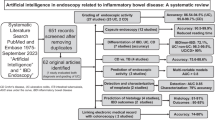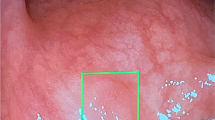Abstract
Purpose of Review
Recently numerous researchers have shown remarkable progress using convolutional neural network-based artificial intelligence (AI) for endoscopy. In this manuscript we aim to summarize recent AI impact on endoscopy.
Recent Findings
AI for detecting colon polyps has been the most promising area for application of AI in endoscopy. Recent prospective randomized studies showed that AI assisted colonoscopy increased adenoma detection rate and the mean number of adenomas per patient compared to standard colonoscopy alone. AI for optical biopsy of colon polyp showed a negative predictive value of ≥90%. For capsule endoscopy, applying AI to pre-read the video images decreased physician reading time significantly. Recently, researchers are broadening the area of AI to quality assessment of endoscopy such as bowel preparation and automated report generation.
Summary
AI systems have shown great potential to increase physician performance by enhancing detection, reducing procedure time, and providing real-time feedback of endoscopy quality. To build a generally applicable AI, we need further investigations in real world settings and also integration of AI tools into pragmatic platforms.
Similar content being viewed by others
References
Papers of particular interest, published recently, have been highlighted as: •• Of major importance
Hirschowitz BI. A personal history of the fiberscope. Gastroenterology. 1979;76(4):864–9.
Demling L, Hagel HJ. Video endoscopy. Fundamentals and problems Endoscopy. 1985;17(5):167–9. https://doi.org/10.1055/s-2007-1018491.
LeCun Y, Bengio Y, Hinton G. Deep learning. Nature. 2015;521(7553):436–44. https://doi.org/10.1038/nature14539.
Corley DA, Jensen CD, Marks AR, Zhao WK, Lee JK, Doubeni CA, et al. Adenoma detection rate and risk of colorectal cancer and death. N Engl J Med. 2014;370(14):1298–306. https://doi.org/10.1056/NEJMoa1309086.
Misawa M, Kudo SE, Mori Y, Cho T, Kataoka S, Yamauchi A, et al. Artificial intelligence-assisted polyp detection for colonoscopy: initial experience. Gastroenterology. 2018;154(8):2027–9.e3. https://doi.org/10.1053/j.gastro.2018.04.003.
Urban G, Tripathi P, Alkayali T, Mittal M, Jalali F, Karnes W, et al. Deep learning localizes and identifies polyps in real time with 96% accuracy in screening colonoscopy. Gastroenterology. 2018;155(4):1069–78.e8. https://doi.org/10.1053/j.gastro.2018.06.037.
Wang P, Xiao X, Glissen Brown JR, Berzin TM, Tu M, Xiong F, et al. Development and validation of a deep-learning algorithm for the detection of polyps during colonoscopy. Nat Biomed Eng. 2018;2(10):741–8. https://doi.org/10.1038/s41551-018-0301-3.
Hassan C, Wallace MB, Sharma P, Maselli R, Craviotto V, Spadaccini M, et al. New artificial intelligence system: first validation study versus experienced endoscopists for colorectal polyp detection. Gut. 2020;69(5):799–800. https://doi.org/10.1136/gutjnl-2019-319914.
Klare P, Sander C, Prinzen M, Haller B, Nowack S, Abdelhafez M, et al. Automated polyp detection in the colorectum: a prospective study (with videos). Gastrointest Endosc. 2019;89(3):576–82.e1. https://doi.org/10.1016/j.gie.2018.09.042.
•• Wang P, Berzin TM, Glissen Brown JR, Bharadwaj S, Becq A, Xiao X, et al. Real-time automatic detection system increases colonoscopic polyp and adenoma detection rates: a prospective randomised controlled study. Gut. 2019;68(10):1813–9. https://doi.org/10.1136/gutjnl-2018-317500Large prospective randomised controlled study for AI.
Enzinger PC, Mayer RJ. Esophageal cancer. N Engl J Med. 2003;349(23):2241–52. https://doi.org/10.1056/NEJMra035010.
Ishihara R, Takeuchi Y, Chatani R, Kidu T, Inoue T, Hanaoka N, et al. Prospective evaluation of narrow-band imaging endoscopy for screening of esophageal squamous mucosal high-grade neoplasia in experienced and less experienced endoscopists. Dis Esophagus. 2010;23(6):480–6. https://doi.org/10.1111/j.1442-2050.2009.01039.x.
Horie Y, Yoshio T, Aoyama K, Yoshimizu S, Horiuchi Y, Ishiyama A, et al. Diagnostic outcomes of esophageal cancer by artificial intelligence using convolutional neural networks. Gastrointest Endosc. 2019;89(1):25–32. https://doi.org/10.1016/j.gie.2018.07.037.
Cai SL, Li B, Tan WM, Niu XJ, Yu HH, Yao LQ, et al. Using a deep learning system in endoscopy for screening of early esophageal squamous cell carcinoma (with video). Gastrointest Endosc. 2019;90(5):745–53.e2. https://doi.org/10.1016/j.gie.2019.06.044.
Guo L, Xiao X, Wu C, Zeng X, Zhang Y, Du J, et al. Real-time automated diagnosis of precancerous lesions and early esophageal squamous cell carcinoma using a deep learning model (with videos). Gastrointest Endosc. 2020;91(1):41–51. https://doi.org/10.1016/j.gie.2019.08.018.
de Groof J, van der Sommen F, van der Putten J, Struyvenberg MR, Zinger S, Curvers WL, et al. The Argos project: the development of a computer-aided detection system to improve detection of Barrett's neoplasia on white light endoscopy. United European Gastroenterol J. 2019;7(4):538–47. https://doi.org/10.1177/2050640619837443.
van der Sommen F, Zinger S, Curvers WL, Bisschops R, Pech O, Weusten BL, et al. Computer-aided detection of early neoplastic lesions in Barrett's esophagus. Endoscopy. 2016;48(7):617–24. https://doi.org/10.1055/s-0042-105284.
de Groof AJ, Struyvenberg MR, Fockens KN, van der Putten J, van der Sommen F, Boers TG, et al. Deep learning algorithm detection of Barrett's neoplasia with high accuracy during live endoscopic procedures: a pilot study (with video). Gastrointest Endosc. 2020;91(6):1242–50. https://doi.org/10.1016/j.gie.2019.12.048.
Hirasawa T, Aoyama K, Tanimoto T, Ishihara S, Shichijo S, Ozawa T, et al. Application of artificial intelligence using a convolutional neural network for detecting gastric cancer in endoscopic images. Gastric Cancer. 2018;21(4):653–60. https://doi.org/10.1007/s10120-018-0793-2.
Cho BJ, Bang CS, Park SW, Yang YJ, Seo SI, Lim H, et al. Automated classification of gastric neoplasms in endoscopic images using a convolutional neural network. Endoscopy. 2019;51(12):1121–9. https://doi.org/10.1055/a-0981-6133.
Luo H, Xu G, Li C, He L, Luo L, Wang Z, et al. Real-time artificial intelligence for detection of upper gastrointestinal cancer by endoscopy: a multicentre, case-control, diagnostic study. Lancet Oncol. 2019;20(12):1645–54. https://doi.org/10.1016/s1470-2045(19)30637-0.
Abu Dayyeh BK, Thosani N, Konda V, Wallace MB, Rex DK, Chauhan SS, et al. ASGE Technology Committee systematic review and meta-analysis assessing the ASGE PIVI thresholds for adopting real-time endoscopic assessment of the histology of diminutive colorectal polyps. Gastrointest Endosc. 2015;81(3):502–16.e1. https://doi.org/10.1016/j.gie.2014.12.022.
Rex DK, Kahi C, O'Brien M, Levin TR, Pohl H, Rastogi A, et al. The American Society for Gastrointestinal Endoscopy PIVI (preservation and incorporation of valuable endoscopic innovations) on real-time endoscopic assessment of the histology of diminutive colorectal polyps. Gastrointest Endosc. 2011;73(3):419–22. https://doi.org/10.1016/j.gie.2011.01.023.
Ignjatovic A, Thomas-Gibson S, East JE, Haycock A, Bassett P, Bhandari P, et al. Development and validation of a training module on the use of narrow-band imaging in differentiation of small adenomas from hyperplastic colorectal polyps. Gastrointest Endosc. 2011;73(1):128–33. https://doi.org/10.1016/j.gie.2010.09.021.
Sikka S, Ringold DA, Jonnalagadda S, Banerjee B. Comparison of white light and narrow band high definition images in predicting colon polyp histology, using standard colonoscopes without optical magnification. Endoscopy. 2008;40(10):818–22. https://doi.org/10.1055/s-2008-1077437.
Kominami Y, Yoshida S, Tanaka S, Sanomura Y, Hirakawa T, Raytchev B, et al. Computer-aided diagnosis of colorectal polyp histology by using a real-time image recognition system and narrow-band imaging magnifying colonoscopy. Gastrointest Endosc. 2016;83(3):643–9. https://doi.org/10.1016/j.gie.2015.08.004.
Chen PJ, Lin MC, Lai MJ, Lin JC, Lu HH, Tseng VS. Accurate classification of diminutive colorectal polyps using computer-aided analysis. Gastroenterology. 2018;154(3):568–75. https://doi.org/10.1053/j.gastro.2017.10.010.
Kudo SE, Misawa M, Mori Y, Hotta K, Ohtsuka K, Ikematsu H, et al. Artificial Intelligence-assisted System Improves Endoscopic Identification of Colorectal Neoplasms. Clin Gastroenterol Hepatol. 2020;18(8):1874–81.e2. https://doi.org/10.1016/j.cgh.2019.09.009.
Mori Y, Kudo SE, Wakamura K, Misawa M, Ogawa Y, Kutsukawa M, et al. Novel computer-aided diagnostic system for colorectal lesions by using endocytoscopy (with videos). Gastrointest Endosc. 2015;81(3):621–9. https://doi.org/10.1016/j.gie.2014.09.008.
Komeda Y, Handa H, Watanabe T, Nomura T, Kitahashi M, Sakurai T, et al. Computer-aided diagnosis based on convolutional neural network system for colorectal polyp classification: preliminary experience. Oncology. 2017;93(Suppl 1):30–4. https://doi.org/10.1159/000481227.
Byrne MF, Chapados N, Soudan F, Oertel C, Linares Perez M, Kelly R, et al. Real-time differentiation of adenomatous and hyperplastic diminutive colorectal polyps during analysis of unaltered videos of standard colonoscopy using a deep learning model. Gut. 2019;68(1):94–100. https://doi.org/10.1136/gutjnl-2017-314547.
Sanchez-Montes C, Sanchez FJ, Bernal J, Cordova H, Lopez-Ceron M, Cuatrecasas M, et al. Computer-aided prediction of polyp histology on white light colonoscopy using surface pattern analysis. Endoscopy. 2019;51(3):261–5. https://doi.org/10.1055/a-0732-5250.
Zachariah R, Samarasena J, Luba D, Duh E, Dao T, Requa J, et al. Prediction of Polyp Pathology Using Convolutional Neural Networks Achieves "Resect and Discard" Thresholds. Am J Gastroenterol. 2020;115(1):138–44. https://doi.org/10.14309/ajg.0000000000000429.
Aoki T, Yamada A, Aoyama K, Saito H, Tsuboi A, Nakada A, et al. Automatic detection of erosions and ulcerations in wireless capsule endoscopy images based on a deep convolutional neural network. Gastrointestinal Endoscopy. 2019;89(2):357–63. e2.
Ding Z, Shi H, Zhang H, Meng L, Fan M, Han C, et al. Gastroenterologist-Level Identification of Small-Bowel Diseases and Normal Variants by Capsule Endoscopy Using a Deep-Learning Model. Gastroenterology. 2019;157(4):1044–54.e5. https://doi.org/10.1053/j.gastro.2019.06.025.
He JY, Wu X, Jiang YG, Peng Q, Jain R. Hookworm detection in wireless capsule endoscopy images with deep learning. IEEE Trans Image Process. 2018;27(5):2379–92. https://doi.org/10.1109/TIP.2018.2801119.
Iakovidis DK, Georgakopoulos SV, Vasilakakis M, Koulaouzidis A, Plagianakos VP. Detecting and locating gastrointestinal anomalies using deep learning and iterative cluster unification. IEEE Trans Med Imaging. 2018;37(10):2196–210. https://doi.org/10.1109/tmi.2018.2837002.
Leenhardt R, Vasseur P, Li C, Saurin JC, Rahmi G, Cholet F, et al. A neural network algorithm for detection of GI angiectasia during small-bowel capsule endoscopy. Gastrointest Endosc. 2019;89(1):189–94. https://doi.org/10.1016/j.gie.2018.06.036.
Zhou J, Wu L, Wan X, Shen L, Liu J, Zhang J, et al. A novel artificial intelligence system for the assessment of bowel preparation (with video). Gastrointest Endosc. 2020;91(2):428–35.e2. https://doi.org/10.1016/j.gie.2019.11.026.
Wu L, Zhang J, Zhou W, An P, Shen L, Liu J, et al. Randomised controlled trial of WISENSE, a real-time quality improving system for monitoring blind spots during esophagogastroduodenoscopy. Gut. 2019;68(12):2161–9. https://doi.org/10.1136/gutjnl-2018-317366.
Author information
Authors and Affiliations
Corresponding author
Ethics declarations
Conflict of Interest
Dr. Wallace reports grants from Fujifilm, Boston Scientific, Olympus, Medtronic, Ninepoint Medical, Cosmo/Aries Pharmaceuticals, personal fees from Virgo Inc., Cosmo/Aries Pharmaceuticals, Anx Robotica (2019), Covidien, GI Supply, other from Virgo Inc., other from Synergy Pharmaceuticals, Boston Scientific, Cook Medical, outside the submitted work
Dr. Lee has nothing to disclose.
Human and Animal Rights and Informed Consent
This article does not contain any studies with human or animal subjects performed by any of the authors.
Additional information
Publisher’s Note
Springer Nature remains neutral with regard to jurisdictional claims in published maps and institutional affiliations.
This article is part of the Topical Collection on Endoscopy and Surgery
Rights and permissions
About this article
Cite this article
Lee, J., Wallace, M.B. State of the Art: The Impact of Artificial Intelligence in Endoscopy 2020. Curr Gastroenterol Rep 23, 7 (2021). https://doi.org/10.1007/s11894-021-00810-9
Accepted:
Published:
DOI: https://doi.org/10.1007/s11894-021-00810-9




